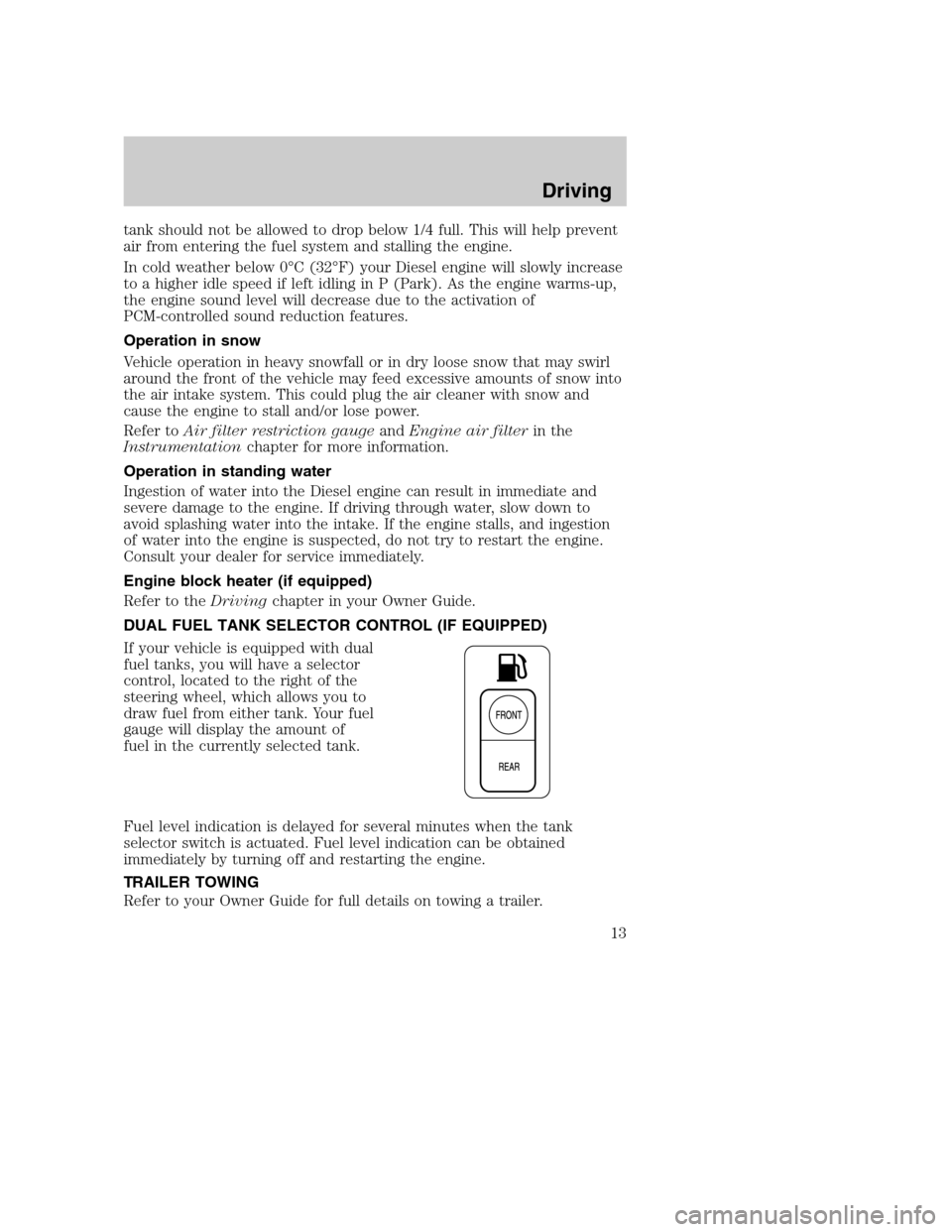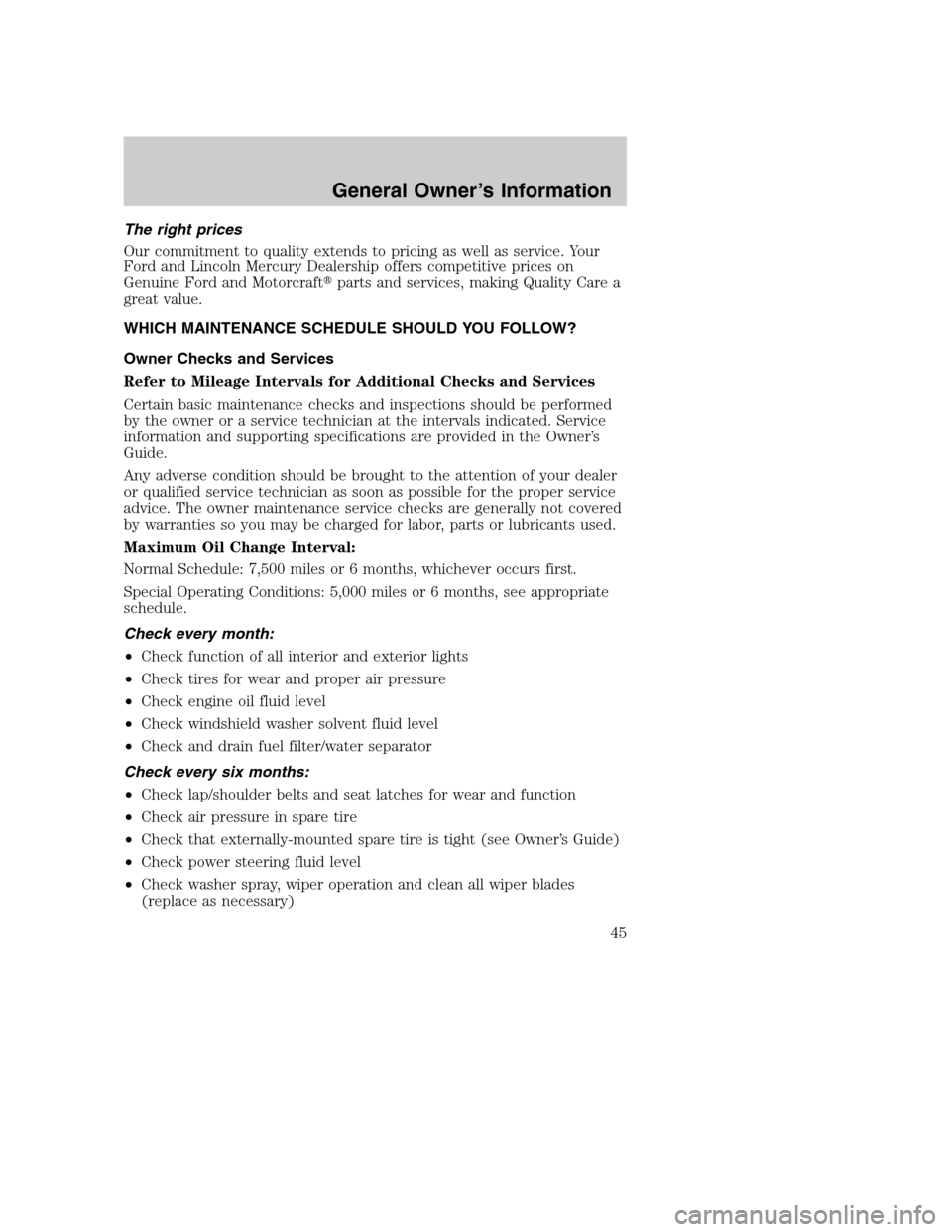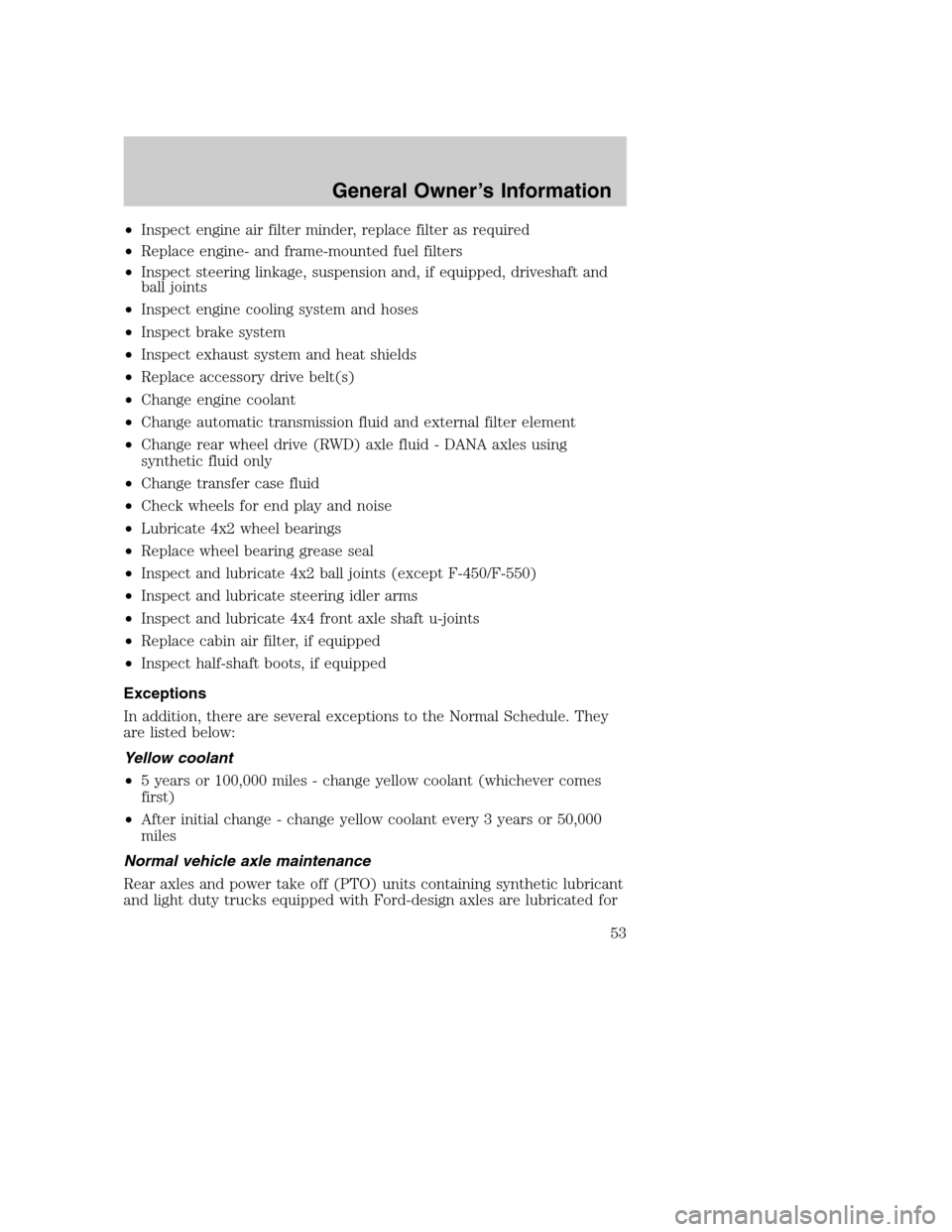Page 13 of 64

tank should not be allowed to drop below 1/4 full. This will help prevent
air from entering the fuel system and stalling the engine.
In cold weather below 0°C (32°F) your Diesel engine will slowly increase
to a higher idle speed if left idling in P (Park). As the engine warms-up,
the engine sound level will decrease due to the activation of
PCM-controlled sound reduction features.
Operation in snow
Vehicle operation in heavy snowfall or in dry loose snow that may swirl
around the front of the vehicle may feed excessive amounts of snow into
the air intake system. This could plug the air cleaner with snow and
cause the engine to stall and/or lose power.
Refer toAir filter restriction gaugeandEngine air filterin the
Instrumentationchapter for more information.
Operation in standing water
Ingestion of water into the Diesel engine can result in immediate and
severe damage to the engine. If driving through water, slow down to
avoid splashing water into the intake. If the engine stalls, and ingestion
of water into the engine is suspected, do not try to restart the engine.
Consult your dealer for service immediately.
Engine block heater (if equipped)
Refer to theDrivingchapter in your Owner Guide.
DUAL FUEL TANK SELECTOR CONTROL (IF EQUIPPED)
If your vehicle is equipped with dual
fuel tanks, you will have a selector
control, located to the right of the
steering wheel, which allows you to
draw fuel from either tank. Your fuel
gauge will display the amount of
fuel in the currently selected tank.
Fuel level indication is delayed for several minutes when the tank
selector switch is actuated. Fuel level indication can be obtained
immediately by turning off and restarting the engine.
TRAILER TOWING
Refer to your Owner Guide for full details on towing a trailer.
Driving
13
Page 23 of 64
IDENTIFYING COMPONENTS IN THE ENGINE COMPARTMENT
F-SuperDuty/Excursion
1. Battery (dual batteries shown)
2. Air filter assembly
3. Power steering fluid reservoir
4. Clutch fluid reservoir (if equipped)
5. Brake fluid reservoir
6. Engine coolant reservoir
7. Engine oil dipstick
8. Engine-mounted fuel filter assembly
9. Engine oil filter
10. Engine oil filler
Maintenance and specifications
Maintenance and specifications
23
Page 45 of 64

The right prices
Our commitment to quality extends to pricing as well as service. Your
Ford and Lincoln Mercury Dealership offers competitive prices on
Genuine Ford and Motorcraft�parts and services, making Quality Care a
great value.
WHICH MAINTENANCE SCHEDULE SHOULD YOU FOLLOW?
Owner Checks and Services
Refer to Mileage Intervals for Additional Checks and Services
Certain basic maintenance checks and inspections should be performed
by the owner or a service technician at the intervals indicated. Service
information and supporting specifications are provided in the Owner’s
Guide.
Any adverse condition should be brought to the attention of your dealer
or qualified service technician as soon as possible for the proper service
advice. The owner maintenance service checks are generally not covered
by warranties so you may be charged for labor, parts or lubricants used.
Maximum Oil Change Interval:
Normal Schedule: 7,500 miles or 6 months, whichever occurs first.
Special Operating Conditions: 5,000 miles or 6 months, see appropriate
schedule.
Check every month:
•Check function of all interior and exterior lights
•Check tires for wear and proper air pressure
•Check engine oil fluid level
•Check windshield washer solvent fluid level
•Check and drain fuel filter/water separator
Check every six months:
•Check lap/shoulder belts and seat latches for wear and function
•Check air pressure in spare tire
•Check that externally-mounted spare tire is tight (see Owner’s Guide)
•Check power steering fluid level
•Check washer spray, wiper operation and clean all wiper blades
(replace as necessary)
General Owner’s Information
45
Page 53 of 64

•Inspect engine air filter minder, replace filter as required
•Replace engine- and frame-mounted fuel filters
•Inspect steering linkage, suspension and, if equipped, driveshaft and
ball joints
•Inspect engine cooling system and hoses
•Inspect brake system
•Inspect exhaust system and heat shields
•Replace accessory drive belt(s)
•Change engine coolant
•Change automatic transmission fluid and external filter element
•Change rear wheel drive (RWD) axle fluid - DANA axles using
synthetic fluid only
•Change transfer case fluid
•Check wheels for end play and noise
•Lubricate 4x2 wheel bearings
•Replace wheel bearing grease seal
•Inspect and lubricate 4x2 ball joints (except F-450/F-550)
•Inspect and lubricate steering idler arms
•Inspect and lubricate 4x4 front axle shaft u-joints
•Replace cabin air filter, if equipped
•Inspect half-shaft boots, if equipped
Exceptions
In addition, there are several exceptions to the Normal Schedule. They
are listed below:
Yellow coolant
•5 years or 100,000 miles - change yellow coolant (whichever comes
first)
•After initial change - change yellow coolant every 3 years or 50,000
miles
Normal vehicle axle maintenance
Rear axles and power take off (PTO) units containing synthetic lubricant
and light duty trucks equipped with Ford-design axles are lubricated for
General Owner’s Information
53